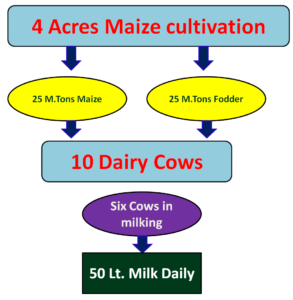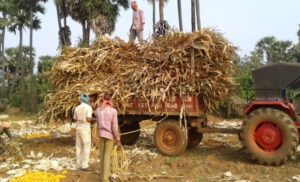Maize Stover is an Alternative in Bovine Nutrition
Gangu Naidu Surla1 Madaru Murali Krishna2
- Assistant Professor, Livestock Farm Complex, College of Veterinary Science, Garividi;, Sri Venkateswara Veterinary University, Tirupati – 517502, India
- Assistant Professor (on Contract), Livestock Production and Management, , Livestock Research Station, Garividi, Sri Venkateswara Veterinary University, Tirupati – 517502, India
Abstract: The basis of milk is fodder, the dairy industry without fodder is not profitable so there should be opportunities to explore alternative ways and make it economical. Livestock in India is growing at a rate of 1.3 percent per annum, according to the Tenth Five Year Plan. The construction of new roads and rail and real estate on another way will reduce much of the cultivable land. Currently, India has a shortage of 61.1% fodder, 21.9% dry fodder, and 64% Concentrates. At present, due to our economic policies, farmers are increasingly interested in growing commercial crops like Maize and Cotton. In such a context, it is most necessary to adopt alternative animal husbandry practices like Maize stover can be used as a feed source. Most of the Maize growers, after collection of maize stalk; burnt the Maize stover at fields immediately to clear the land for next crop planning. To utilize the stover effectively, farmers can use advanced farm machinery like Maize harvesters, Baler machines, and Chaff cutters to chaff it and use it as dry fodder as well as silage making for future needs. The ideal farming system which includes, a farmer holding four acres of land, and has access to water for irrigation, can cultivate the maize crop commercially three times a year, and produce about 25 tons of fodder (fodder and dry fodder) as well as 25 M.Tons of maize grains from those four acres of land, to fit about 10 cattle feeding throughout the year, so that if at least 6 crossbred cattle out of ten in milking, the yield will not be less than about 40 liters per day. By the sale of these milk and Maize grains, the farmers would get better profits and perfect utilization of maize crops as a fodder resource.
| 1. Green fodder,2. Dry fodder3. Concentrate feeds |
Livestock fodder can be divided into three types: The Requirement of Green fodder for cattle is about 30- 40 Kgs. per day, available through agricultural-based products. “Maize” is one of the most important cereal crops, and staple food for humans as well as domestic animals (1). India is the 6th largest producer after America and China in Maize production, and it is creeping up year by year (2). In Western countries such as the United States, corn is 35 percent cultivated, making it the “economic driver” of the United States (3). It is the most diverse and versatile growing crop. The crop was introduced to India by the Portuguese in the 17th century. This crop is mostly grown in Kharif. Maize is the third most widely grown crop in India after wheat and rice. Especially maize, baby corn and sweet corn are the major crops. Baby corn and sweet corn can be used as cornmeal and then the rest of the plant can be used as fodder completely. It has also been researched in the states of Punjab and Haryana and confirmed that it is very good for digestion in cattle and can be used as fodder.
| Loading of Hay at Maize fields |
| Harvesting of Maize stover |
Maize production capacity has increased to a record level in recent times, and particularly in southern parts of India. We have reached the level of import-export. Maize is used in 52% of poultry feed, 24% of the food we eat, and 11% of livestock feed (4).
Table 1:
Nutritive values of different fodders:
| S.No. | Fodder Variety | Harvesting time | Crude Protein | Total Digestible Nutrients |
| 1 | Maize | Silk to milk stage | 11.8 | 68.52 |
| 2 | Sorghum | At flowering stahe | 10.7 | 62.55 |
| 3 | Jowar | At flowering stahe | 8.7 | 60.57 |
| 4 | Hybrid Napier | Harvest at Height of 1M | 11.7 | 60.55 |
| 5 | Guinea Grass | Harvest at Height of 1M | 10.8 | 60.57 |
Table 2:Nutritive values of different parts of Maize:
| S.No. | Nutrients | Stem | Leaves |
| 1 | Dry matter | 28.63 | 15.57 |
| 2 | Crude Protein | 7.4 | 13.4 |
| 3 | Crude Fibre | 45.19 | 28.7 |
Numerous researches have shown that maize has high nutritional value as compared to other grasses. Similarly, corn leaves are high in protein (13.4%) and low in fiber than the stem portion of the Maize as indicated in Table No. 2. During the Rabi season, maize was widely cultivated throughout Southern India. The small and marginal farmers harvest corn, just freshly given as green succulent. It is also beneficial to use it a dry fodder, it is completely dried, and also urea treated fodder. Maize can also be used as silage.
Silage Preparation – Requirement:
The idea is to provide nutritious feed with highly nutritious throughout the year. During November and December, the growth of regular green fodders has stunted growth due to cold and snow, as well as the availability of water decreases during the summer season due to water turbulence from May to June. This approach is very much needed at times like this. Silage can also be made from sorghum husk. The optimum moisture content should be 70% for making silage from maize stover, the moisture content of maize stover is low and the quality of silage is good.
The place where the Silage pits are made, first it should be on a high place. Sizes 1.5 M. Width, 2.4 M. Length, 1.2 M (5). A deep rectangular pit should be dug and the bottom part of the walls should be constructed with cement to prevent waterlogging. 15 kg of fodder can be stored in one Cubic Ft. area, and should be well-drained without infiltration. Sprinkle 2% jaggery and 1% salt and lactobacillus culture diluted in water were added between the layers (6). In this way, the pits should be filled to a height of one meter and covered with straw and manure or soil to prevent rainwater runoff. Potted grass is ready for use in two to three months. The silage in this container can be stored for up to three years. Once used, it should be used within a month. Dark brown, black, and sour-smelling silage should not be used (7). By converting maize husk into silage as above, it can be converted into high nutritive fodder.Can be used as Dry fodder:
| Table 3.: nutritive value of Dried maize | |
| Crude Proteins | 4.7% |
| Cellulose | 37.5% |
| Hemi cellulose | 26% |
| Moisture | 9-12% |
The requirement of dry fodder is normally one kg of dry fodder per 50 kg body weight, which is also good to offer during night times due to produce metabolic heat when they consume (8). Wheat and Paddy straws are the major crops in India; these can be fed without chaffing. But the cost of these dry fodders was high, an alternative dry fodder after wheat and paddy straw is Maize stover. This is an available very economic and majorly grown crop in southern parts of India. The traditional use of paddy straw has a high fiber content and is low in digestible nutrients. It is devoid of protein and is likely to contain toxins such as selenium. Feeding the paddy straw every day just to fill the stomach, which will reduce the milk yield and productivity of the dairy cattle. The use of maize stover in dried form as an alternative, and has the potential to provide higher nutritional value and better productivity as indicated in Table No. 3. If the corn husk is removed, fed to the cattle after chopping with the help of a chaff cutter, a higher percentage of fodder is likely to be consumed instead of wasted? When some farmers grow this crop commercially, the stalk is burned for the next crop. At such times the dairy farmers should utilize it. Maize is also high in protein, fiber, carbohydrates such as cellulose and hemi-cellulose, especially than other dry fodder. Dairy cattle are better animals able to digest cellulose and hemi-cellulose (9). Thus the health of the cattle and the increase in milk is also very beneficial to the farmer. The use of such highly nutritious agricultural products will enable dairy farmers to become financially viable.
References:1. Maize: Nutrition Dynamics and Novel Uses | Dharam Paul Chaudhary | Springer2. The World’s 6 Biggest Corn Producers (investopedia.com)3. https://farmer.gov.in/m_cropstaticsmaize.aspx4. Maize-production-system-book.pdf (icar.gov.in) 5. sailage.pdf (dairymate.in) 6. Venkataramanan, R., Sreekumar, C., Anilkumar, R., Selvaraj, P., Vidhya, N.M. and Mathagowder, I., 2010. Effect of jaggery on the quality and intake levels of maize silage. Tropical animal health and production, 42(5), pp.1027-1029.7. Savoie, P. and Jofriet, J.C., 2003. Silage storage. Silage science and technology, 42, pp.405-467.8. 8.Feeding cost per day | Dairy Knowledge Portal9. 9.Lasek, O., Barteczko, J., Borowiec, F., Smulikowska, S. and Augustyn, R., 2012. The nutritive value of maize cultivars for broiler chickens. Journal of Animal and Feed Sciences, 21(2), pp.345-360.
https://lallemandanimalnutrition.com/en/asia/whats-new/maize-stover-a-valuable-alternative-feed/






